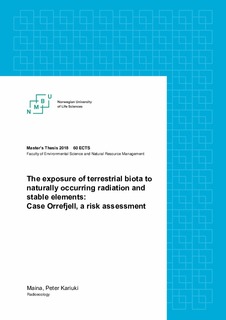| dc.contributor.advisor | Skipperud, Lindis | |
| dc.contributor.advisor | Wærsted, Frøydis Meen | |
| dc.contributor.advisor | Jensen, Louise Kiel | |
| dc.contributor.author | Maina, Peter Kariuki | |
| dc.coverage.spatial | Norway, Troms, Orrefjell | nb_NO |
| dc.date.accessioned | 2018-10-24T12:38:59Z | |
| dc.date.available | 2018-10-24T12:38:59Z | |
| dc.date.issued | 2018 | |
| dc.identifier.uri | http://hdl.handle.net/11250/2569352 | |
| dc.description.abstract | Naturally occurring radioactive materials (NORM) can be found all over the world. Investigations of possible effects on humans and the environment have mostly focused on exploited sites like mines and their vicinity, while less attention has been given to undisturbed sites despite the potential risk. The Orrefjell area in Northern Norway has one the largest uranium deposits in Norway, and elevated levels of radionuclides in soil and biota can be expected.
This master thesis is part of the project “Case Orrefjell” supported by the flagship hazardous substance at the FRAM High North Research Centre for Climate and Environment, Tromsø, Norway. The aim of this thesis was to examine the risk and possible impact of enhanced levels of NORMs and other selected stable elements in an undisturbed area on non-human biota. | nb_NO |
| dc.description.sponsorship | FRAM High North Research Centre for Climate and the Environment | nb_NO |
| dc.language.iso | eng | nb_NO |
| dc.publisher | Norwegian University of Life Sciences, Ås | nb_NO |
| dc.rights | Attribution-NonCommercial-NoDerivatives 4.0 Internasjonal | * |
| dc.rights.uri | http://creativecommons.org/licenses/by-nc-nd/4.0/deed.no | * |
| dc.title | The exposure of terrestrial biota to naturally occuring radiation and stable elements : case Orrefjell, a risk assessment | nb_NO |
| dc.type | Master thesis | nb_NO |
| dc.description.localcode | M-RAD | nb_NO |

